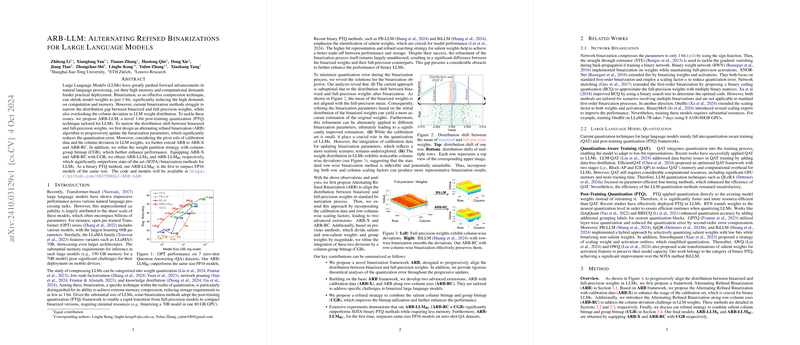Overview of ARB-LLM: Alternating Refined Binarizations for LLMs
The paper "ARB-LLM" presents a novel approach to enhancing binarization in LLMs to address their high computational and memory demands. Binarization compresses model weights to one bit, offering a promising solution for deploying LLMs in resource-constrained environments. Despite its potential, traditional binarization methods often encounter significant challenges, particularly in aligning the distribution of binarized weights with that of their full-precision counterparts. This misalignment, along with column deviation in weight distribution, poses obstacles to achieving efficient model performance.
Proposed Method: ARB-LLM
The authors introduce ARB-LLM, an innovative 1-bit post-training quantization (PTQ) technique specifically designed for LLMs. The core component is the Alternating Refined Binarization (ARB) algorithm, which iteratively updates binarization parameters to minimize quantization errors. Notably, the algorithm ensures a more accurate representation of the original full-precision weights by addressing distribution shifts.
To further enhance the performance, the paper extends ARB into two variants: ARB-X and ARB-RC. These models incorporate calibration data and account for row and column deviations in the weight matrix. The introduction of a column-group bitmap (CGB) for refining weight partitioning elevates binarization outcomes, leading to ARB-LLM and ARB-XRCRLLM models.
Numerical Results and Contributions
Experimentation demonstrates that ARB-LLM outperforms state-of-the-art (SOTA) methods in binarization, even surpassing FP16 models of equivalent size. The paper provides rigorous theoretical analysis supporting the reduction in quantization error through iterative updates. Furthermore, ARB-LLM emerges as the first binary PTQ method to exceed FP16 models on zero-shot question answering datasets in terms of accuracy.
Key contributions of this work include:
- Algorithmic Innovation: ARB, ARB-X, and ARB-RC significantly enhance binarization precision by progressively aligning with full-precision weight distributions.
- Efficiency and Scalability: The implementation effectively lowers computational costs and memory usage, essential for deploying LLMs in mobile and edge devices.
- Advanced Extensions: Tailored solutions for leveraging calibration data and accommodating weight distribution peculiarities lead to substantial performance gains.
Implications and Future Directions
The implications of ARB-LLM on the practical deployment of LLMs are profound. By advancing weight binarization techniques, this method opens up pathways for broadening the reach of complex models into less powerful hardware environments, facilitating wider application in real-time scenarios.
Theoretically, this paper sets a precedent for addressing weight distribution alignment, suggesting potential future explorations into refining quantization approaches further. Upcoming research might focus on extending these techniques to other neural architectures or adapting them to integrate seamlessly with dynamic learning tasks.
Conclusively, ARB-LLM represents a significant methodological advancement in LLM quantization, laying groundwork for both theoretical innovations and practical applications in artificial intelligence.
